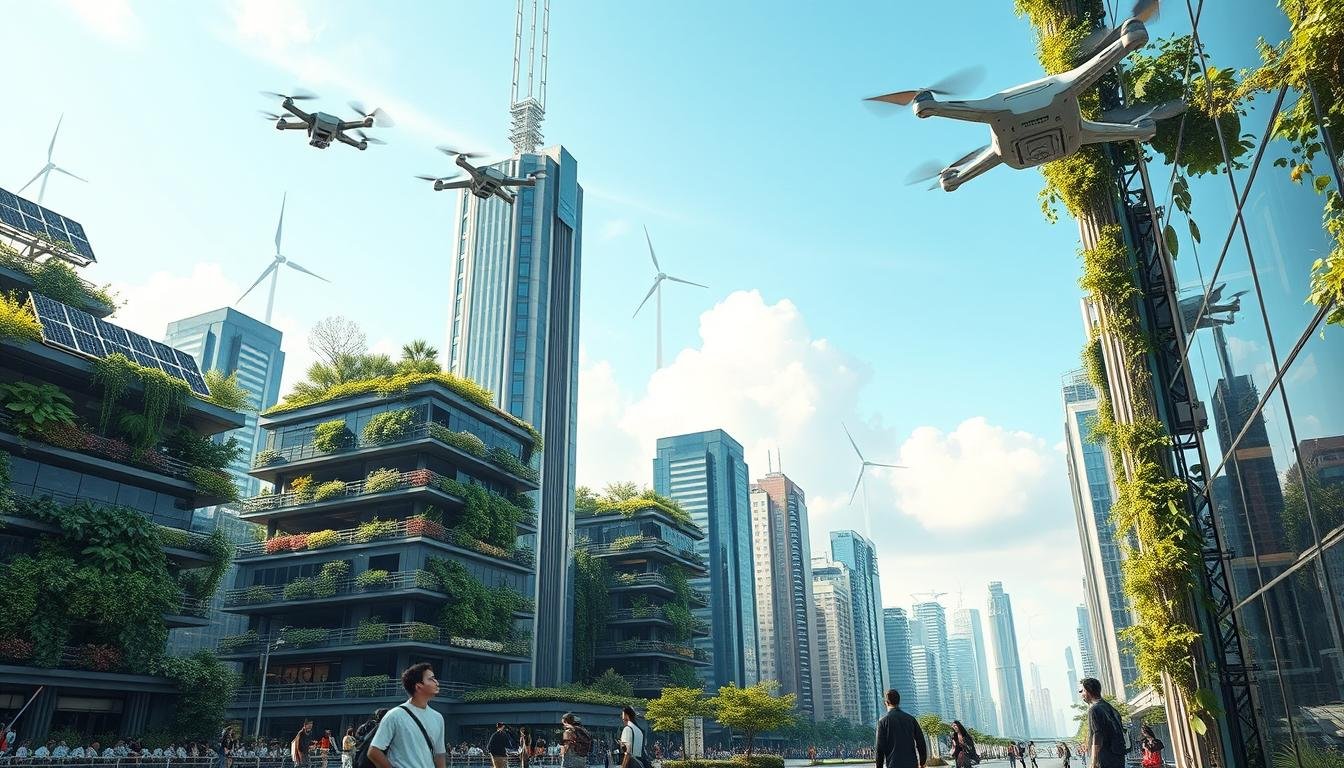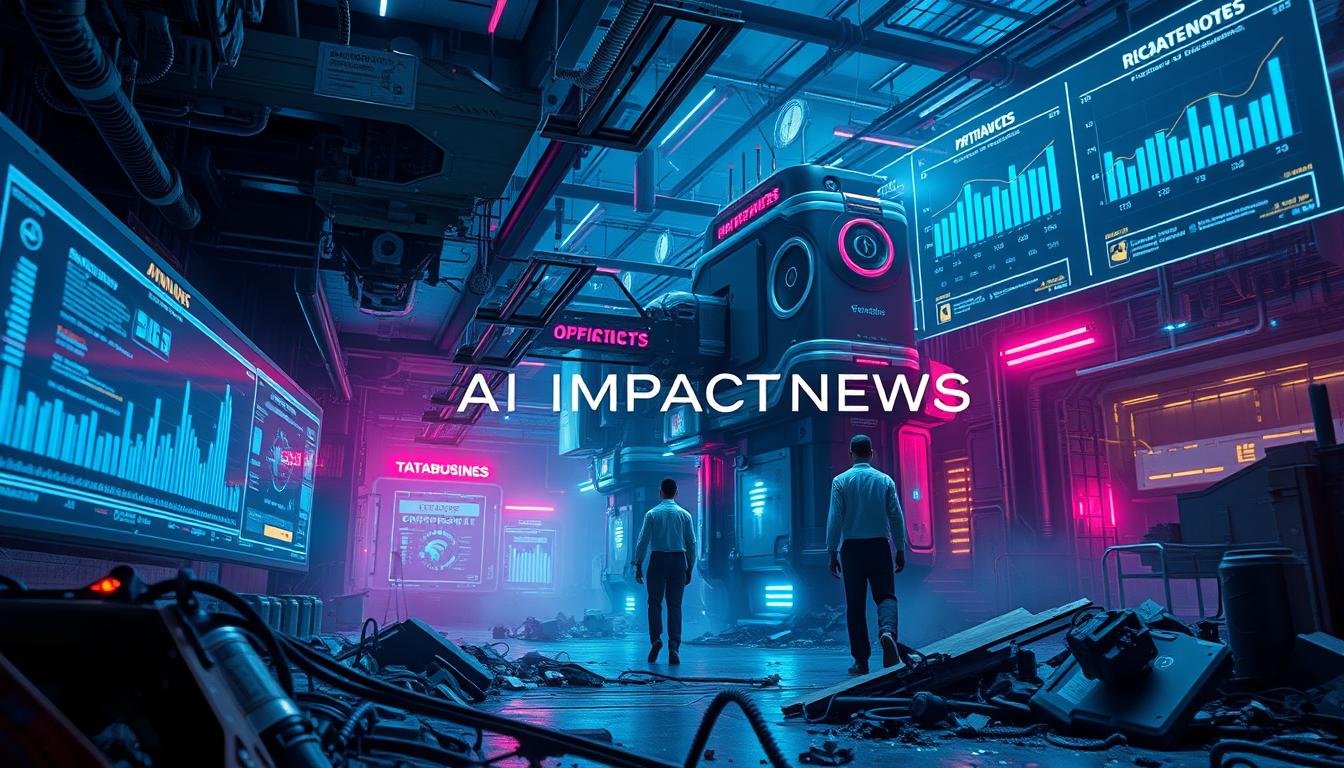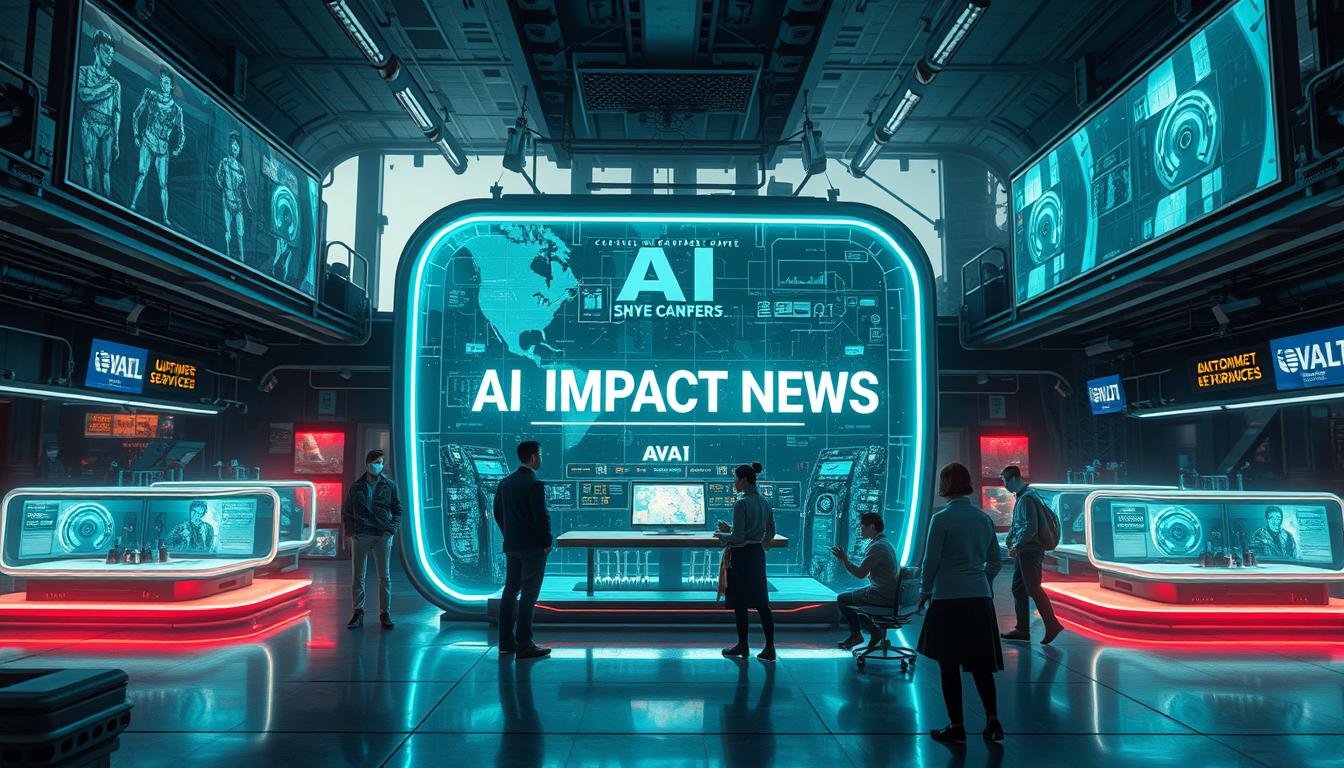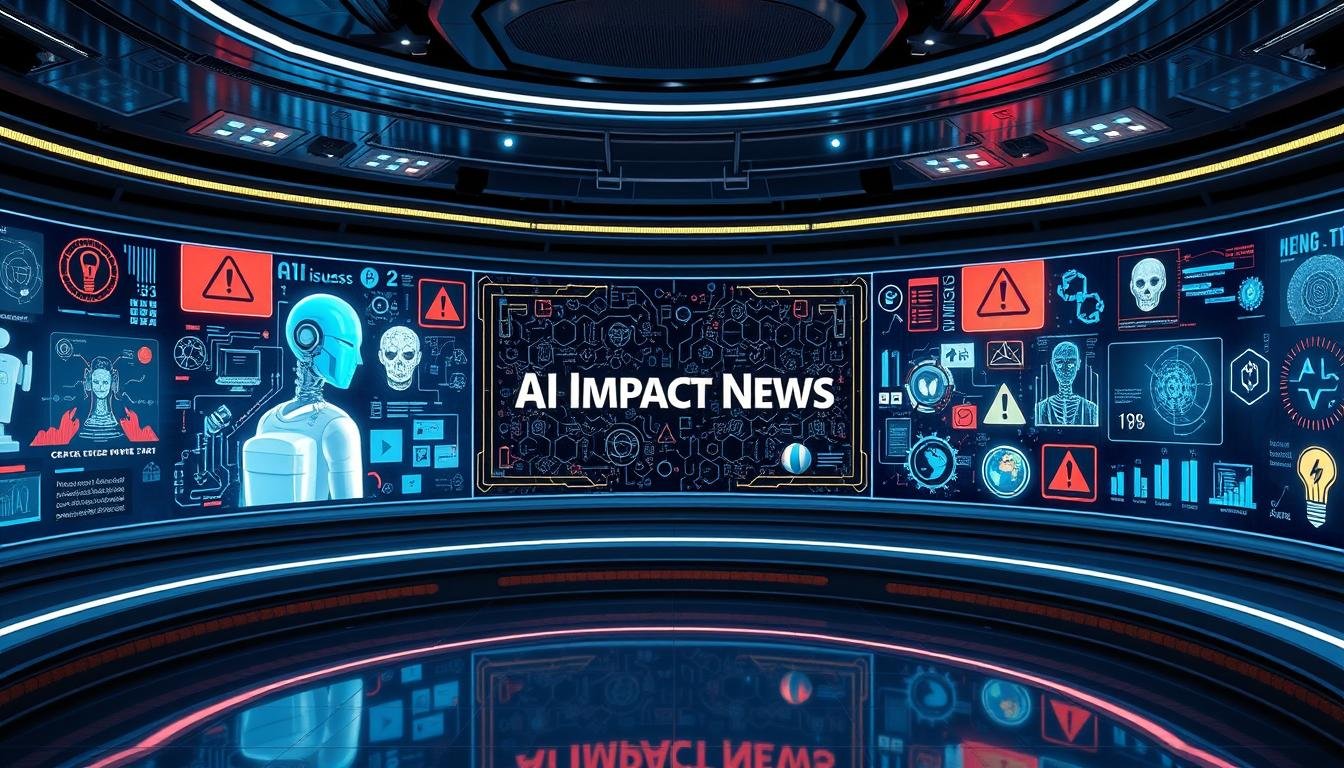You’re about to discover how AI affects climate change. You’ll see both the risks and chances this tech offers. Understanding AI’s role in fighting climate change is key.
Did you know AI’s training can cause a lot of carbon emissions? For example, OpenAI’s GPT-3 training released about 500 tons of carbon dioxide. This shows AI’s environmental impact and its potential to help solve climate change.
As you explore AI and climate change, you’ll find out how AI can help. It can improve climate models and save energy. AI is a big player in solving climate change, with both good and bad sides.
Key Takeaways
- AI can greatly affect climate change, with both risks and chances to solve it.
- Developing and using AI must be done with care to lessen its environmental harm and boost its benefits in fighting climate change.
- AI can enhance climate models, save energy, and lead to green solutions, making it a vital tool in tackling climate change.
- Using AI to fight climate change needs a deep grasp of its complex ties with climate change and the environment.
- By using AI wisely and sustainably, we can find new ways to tackle climate change and build a greener future.
Understanding the Connection Between AI and Climate Change
You are at the forefront of a revolution that will change human history. The link between AI and climate change is complex. As you explore environmental science, you’ll see AI’s crucial role in tackling the climate nexus.
AI is not just for tracking climate patterns. It can also improve resource use, predict disasters, and find key conservation spots. The vast potential of AI to change our approach to climate change is yours to unlock.
- Forecasting weather and predicting disasters
- Optimizing resource use and cutting waste
- Finding and protecting key conservation areas
- Creating new tech and materials to lower emissions
The bond between AI and climate change is clear. As you progress, you’ll influence our planet’s future. Will you work towards a better world, or face the challenges ahead? The decision is yours.
| AI Application | Climate Change Impact |
|---|---|
| Weather forecasting | Predicting natural disasters and optimizing resource usage |
| Resource optimization | Reducing waste and minimizing environmental impact |
| Conservation | Identifying areas of high conservation value and developing protection strategies |
How AI is Revolutionizing Climate Prediction Models
You are on the cusp of a revolution in climate prediction, driven by the power of AI. AI analyzes vast amounts of historical and real-time environmental data. This leads to more precise climate predictions, crucial for understanding and mitigating climate change.
AI can detect patterns in data and make accurate predictions about future outcomes. This is especially useful in climate prediction. For example, AI models can improve hurricane tracking by analyzing historical data and satellite imagery. This helps save lives and reduce economic losses.
Some key benefits of AI in climate prediction include:
- Predicting short-term rainfall with improved accuracy
- Enhancing hurricane tracking predictive accuracy
- Optimizing energy consumption and reducing waste
Remember, the effectiveness of AI in climate prediction depends on high-quality data. Incomplete or biased data can lead to inaccurate models and poor decisions. But with the right data and algorithms, AI can be a powerful ally in fighting climate change.
AI-Powered Solutions for Reducing Carbon Emissions
You can help cut down carbon emissions with AI. A big area is smart grid systems. These systems use AI to manage energy better. They predict needs, find problems, and adjust supplies, cutting down carbon emissions.
AI also helps with energy optimization. It looks at how much energy you use and finds ways to use less. This includes smart buildings that control lights and heat to save energy.
- Improved energy efficiency
- Reduced carbon emissions
- Enhanced grid resilience
- Optimized energy consumption
Using AI can make our future greener. It helps lower your carbon footprint and fights climate change. AI, smart grid, and energy optimization are key to a cleaner future.
| AI-Powered Solution | Benefits |
|---|---|
| Smart Grid Management Systems | Optimized energy distribution, reduced carbon emissions |
| Energy Optimization | Improved energy efficiency, reduced waste |
Machine Learning Applications in Environmental Protection
You are leading a revolution that combines machine learning and environmental protection. This powerful mix helps you spot unusual patterns and similarities in data. It’s a key tool for saving our planet. With machine learning algorithms, you can watch climate changes, track animal numbers, and use resources better.
Some of the main applications of machine learning in environmental protection are:
- Detecting changes in forest cover and predicting deforestation hotspots
- Identifying and tracking sources of ocean pollution
- Analyzing data for sustainable fisheries management
- Enhancing climate modeling by processing vast amounts of data related to weather patterns, sea levels, and greenhouse gas emissions
By using machine learning and applications, you can really help protect the environment. It’s time to take action, and with the right tools and knowledge, you can help save our planet.
| Application | Description |
|---|---|
| Forest Conservation | Real-time monitoring using AI-powered satellite imagery |
| Ocean Pollution Tracking | Identifying and tracking sources of ocean pollution |
| Climate Modeling | Processing vast amounts of data related to weather patterns, sea levels, and greenhouse gas emissions |
The Dark Side: AI’s Carbon Footprint
Exploring AI, you’ll find its big carbon footprint. Data centers and model training cost the environment a lot. For example, ChatGPT uses 10 times more electricity than Google Search for one request. This shows we need to think about both progress and the planet.
To lessen AI’s harm, we must switch to green AI systems. We can use clean energy, improve data center work, and make AI smarter. Your choices matter. Support companies that care about the planet.
Some important facts to remember:
- Making a 2 kg computer needs 800 kg of raw materials.
- AI might soon use six times more water than Denmark.
- AI models use as much energy as charging a smartphone to make one image.
Understanding AI’s dark side and working to fix it helps our future. We need tools to measure AI’s carbon cost. Your actions can make a big difference. Let’s work together for a greener tomorrow.
| Category | Environmental Impact |
|---|---|
| Data Center Energy Consumption | High energy consumption, contributing to greenhouse gas emissions |
| Training Model Environmental Costs | Substantial water and land usage, resulting in significant carbon footprint |
| Renewable Energy Sources | Reduced carbon emissions, mitigating AI’s environmental impact |
Smart Cities and AI-Driven Climate Solutions
Get ready to see the future of city planning. Smart cities and AI-driven climate solutions are coming together. They will make cities more green and strong.
AI helps cities use less energy, throw away less trash, and get ready for disasters better.
Some big wins of AI in smart cities are:
- Smart grids save energy
- AI helps cities get ready for disasters
- AI makes waste management better
Studies show AI can cool cities by up to 10°F (5.6°C). It does this with green roofs and shiny materials. AI also makes weather forecasts 50% more accurate.

AI and climate solutions can make cities better for people. They improve air, cut down on pollution, and make life better. Join the movement by supporting smart cities and AI-driven climate solutions.
| Benefits of AI-Driven Climate Solutions | Description |
|---|---|
| Improved Energy Efficiency | Optimized energy consumption through smart grid management systems |
| Enhanced Disaster Preparedness | Predictive analytics for improved disaster response and recovery |
| Reduced Waste and Improved Resource Management | Smart waste collection and recycling systems for reduced waste and improved resource management |
AI’s Role in Renewable Energy Integration
AI is key to the future of energy. It can cut down energy waste by 15-20%. This is vital for a green future, where solar and wind power are more crucial.
AI smart grids can handle a 30% rise in renewable energy by 2030. This move helps us use less fossil fuel and fight climate change. AI makes energy use more efficient and green.
Some benefits of AI in renewable energy include:
- Improved energy distribution and reduced waste
- Enhanced efficiency of solar panels and wind turbines
- Predictive maintenance and reduced downtime
- Optimized energy storage solutions
Using AI in renewable energy helps us build a greener future. It can cut energy use by 10-20% and boost renewable energy efficiency by 5-15%. AI is a powerful ally in the battle against climate change. Think about how AI can shape your energy plans and help create a sustainable world.
| Renewable Energy Source | AI-Driven Optimization | Potential Savings |
|---|---|---|
| Solar Power | 10-15% increase in efficiency | Up to 20% reduction in energy costs |
| Wind Farm | 5-10% increase in efficiency | Up to 15% reduction in energy costs |
Environmental Monitoring and Conservation Through AI
You are leading a revolution that uses AI for environmental monitoring and conservation. AI algorithms help track environmental patterns and wildlife populations. They also improve how we use resources. This leads to better conservation strategies and less environmental harm.
AI has many uses in environmental monitoring and conservation. Here are a few examples:
- Tracking deforestation in the Amazon rainforest using machine learning algorithms analyzing satellite images
- Monitoring animal populations in wildlife reserves using AI-powered cameras and sensors
- Predicting climate-related events and identifying areas of high conservation value

Using AI for environmental monitoring and conservation can greatly help our planet. It can predict climate events or find important conservation areas. AI is a powerful tool for making a real difference.
| Application | Description |
|---|---|
| Deforestation tracking | Using machine learning algorithms to analyze satellite images and track deforestation patterns |
| Wildlife population monitoring | Using AI-powered cameras and sensors to monitor animal populations in wildlife reserves |
| Climate-related event prediction | Using AI to predict climate-related events and identify areas of high conservation value |
Future Challenges and Opportunities in AI Climate Technology
Looking ahead, AI climate technology faces big challenges and chances. The growth of emerging technologies is key to tackling climate change. Yet, it also brings worries about energy use and the planet’s health.
The policy side of AI climate tech is complex. Governments and groups must find a balance. They need to push for new ideas and protect the environment and people. You can help shape AI climate tech’s future by staying up-to-date and involved.
Some major hurdles and chances in AI climate tech are:
- Lowering energy use and carbon emissions from AI systems
- Creating green and eco-friendly AI tech
- Creating good policies and rules for AI in fighting and adapting to climate change
As we move forward, we must think about AI climate tech’s effects on our world and people. By tackling these challenges and chances together, we can build a greener and fairer future for everyone.
Conclusion: Shaping a Sustainable Future with AI
As we wrap up our look at AI’s role in fighting climate change, the future is bright. AI can lead us to a greener tomorrow. It can make our energy use better, our travel more efficient, and farming more precise. This tech can greatly cut down our carbon emissions and lessen climate change’s harm.
To make this vision real, we must work together. We need to use AI wisely, focusing on green goals. This means using it for smart energy grids and keeping an eye on resources. The time to start is now.
We can create a world where AI helps us make better choices. It can help us use our resources well and protect our planet. Let’s take on this challenge with strong will. We’re doing it for our families, our kids, and the future.








Leave a Reply